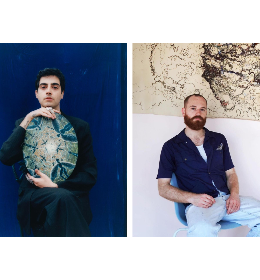Daniel Canogar doesn’t really like the title ‘digital artist’, it is “kind of pigeonholed as a specific kind of artwork that I don’t totally identify with,” he explains. Yet there is no escaping the fact that the artist’s work inherently questions how technology has affected and changed us. His works first see the spark of life in junk yards, “where things go to die,” Canogar nurtures them back to life, giving new purpose to CDs, 35mm film, keyboards and calculators teetering on the edge of obsoleteness. He tells me about Sikka, “made with 360 DVDs all clustered in a circle; this piece has a projection onto the CDs of a video which is made from fragments and clips from the DVDs themselves. Because it is placed where the altar was in the church, it’s almost like a stain glass window,” part of a recent important solo exhibition in Murcia in an 18th-century converted church.
"Technology for us is a tremendous dilemma"
But how does Canogar view the digital technology that fuels a large part of his practice? “Technology for us is a tremendous dilemma, all these contradictions that it brings… I think art in general attempts to address the moment. It looks to reflects issues and events that are affecting our daily lives at any given moment, and of course technology is having a huge influence on our daily life.”
Despite the fact that Canogar hopes for more attention to be awarded to technology issues in art and the art market, his practice is embedded in the long tradition of fascination with technology and its use in the visual arts “there is already a legacy around the use of technology,” he explains. “We could go right back to the early 20th century and how photography became incorporated, and even further back to when different artists were already thinking about electricity and lighting. This new development, the digital, is bringing these issues back again.”
He is inspired by
Nam June Paik and
Christian Marclay and reiterates the inherent link between the materials and their function; interestingly feeling guided by the theme of light and dark, something that he calls “a very Spanish theme.”
"I think that the general public tends to be more attune to new media art than the professional art world public."

Spain, where Canogar lives and works, is a fertile land for a digital artist, “there are some important institutions here in Spain,” citing theTelefonica Institution and the LABoral Centro de Arte. Although he remarks, “I don’t know if it is particular to Spain to be honest, but I do think that the general public tends to be more attune to new media art than the professional art world public.” His upcoming projects do seem to mirror this “resistance” or “suspicion” exuded by the professional art world, he tells me that he is working on several-site specific commissions for private homes as well as piece company lobby and another for a new Royal Caribbean ship. However it would be entirely fallacious to claim that Canogar does not have institutional value, his work forms part of the contemporary collections of some of the country’s most prestigious museums including the Museo Nacional Centro de Arte Reina Sofia and the Museo de Arte Contemporáneo de Castilla y León.
Image credits: Sikka Magnum 2013; AC 2014










